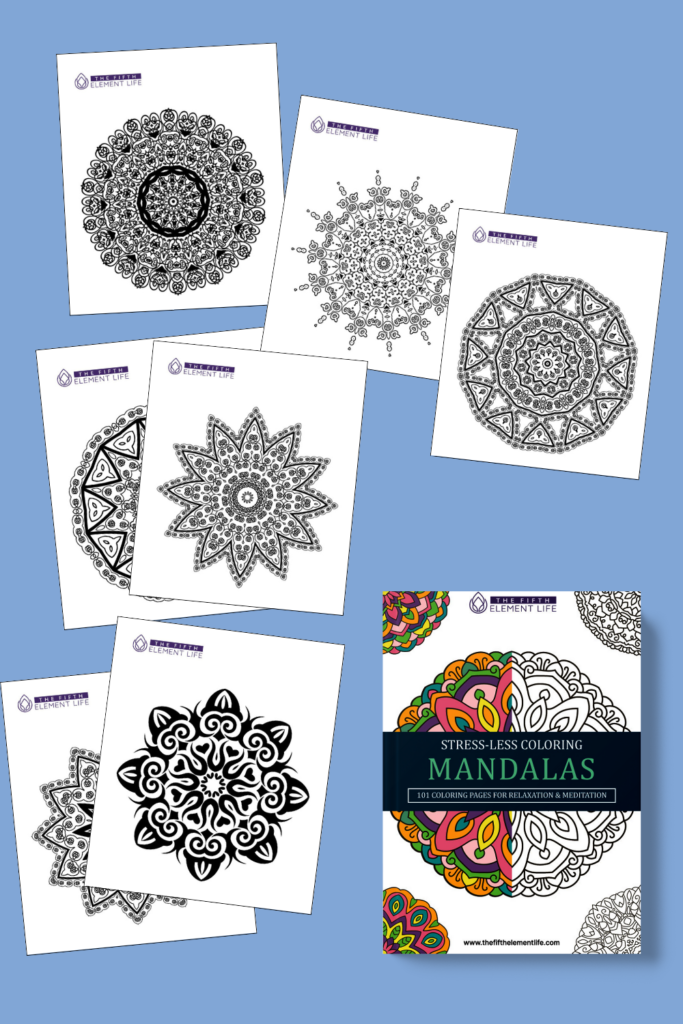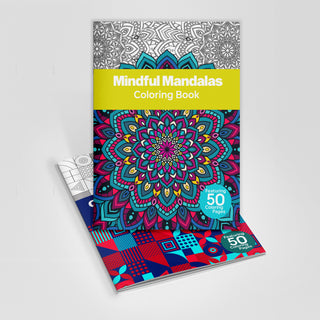Mandalas have been around for centuries and have captivated people of all ages and backgrounds. But the ones who are not familiar with it often ask, what is a mandala? What does it look like?
From their intricate designs to their therapeutic qualities, mandalas have proven to be a powerful tool for mindfulness and relaxation.
Derived from the Sanskrit word for circle, mandalas are spiritual and ritual symbols in Hinduism and Buddhism.
These intricate circular designs feature repeating patterns and symmetrical shapes, often with a central focal point.
Mandalas have been used for meditation, prayer, and healing, with the circular shape representing wholeness and the universe.
In recent years, the popularity of mandalas has skyrocketed as people have discovered their calming effects.
Many have turned to mandala coloring pages as a way to reduce stress and anxiety, while also engaging in a creative outlet.
Coloring mandalas can help to improve focus, promote relaxation, and encourage mindfulness.
Mandalas have become an integral part of the modern self-care movement, with many people incorporating them into their daily routines.

Whether you are a beginner or a seasoned artist, mandala coloring pages are a great way to explore the world of mandalas and reap the benefits of this ancient art form.
So grab your coloured pencils and get ready to embark on a journey of mindfulness and creativity!
What Is A Mandala?
A mandala is a circular design that originated in ancient India.
The word "mandala" comes from Sanskrit, a language used in ancient India, and it means "circle" or "center."
The design of a mandala is typically intricate and features repeating patterns and shapes that radiate outward from the center of the circle.
Mandalas have been used in various spiritual and religious traditions throughout history, including Hinduism, Buddhism, and Jainism. In these traditions, mandalas are used as a tool for meditation and spiritual growth.
The intricate design of the mandala represents the universe and the interconnectedness of all things. By focusing on the mandala and its intricate details, practitioners can quiet their minds and connect with the divine.
Mandalas have also been used in art and architecture throughout history. In ancient Greece, mandalas were used in the design of amphitheaters and other public spaces. In Islamic art, mandalas were used in the design of mosques and other religious buildings.
The use of mandalas in art and architecture continued throughout the Renaissance and into modern times.

In recent years, mandalas have become popular as a tool for stress relief and relaxation.
Coloring books featuring intricate mandala designs have become a popular way for people to unwind and tap into their creative side.
The process of coloring can be meditative, allowing people to focus on the present moment and forget about their worries and stresses.
RELATED: 135 Positive Affirmations For When You’re Feeling Anxious
Overall, a mandala is a powerful symbol of unity, balance, and harmony.
Whether used for spiritual growth, artistic expression, or stress relief, the intricate and beautiful design of the mandala continues to captivate and inspire people around the world.
The circular design of the mandala reminds us that everything is connected, and that by focusing on the present moment, we can connect with the divine and find inner peace.
The History Of Mandalas
The history of mandalas is a fascinating and complex one, spanning many cultures and traditions throughout the centuries.
The word "mandala" comes from the Sanskrit language and means "circle" or "center." In its most basic form, a mandala is a geometric design that represents the universe and the interconnectedness of all things.
Mandalas have been used in various spiritual and religious traditions throughout history, including Hinduism, Buddhism, and Jainism.
In Hinduism, mandalas were used as a tool for meditation and spiritual growth, often featuring intricate designs and patterns that represented different deities and aspects of the divine.
In Buddhism, mandalas were used in tantric practices and as a form of spiritual guidance. Tibetan Buddhist monks were known for creating intricate sand mandalas as part of their meditation practices.
The use of mandalas in art and architecture is also prevalent throughout history.
In ancient Greece, mandalas were used in the design of amphitheaters and other public spaces. In Islamic art, mandalas were used in the design of mosques and other religious buildings.
The use of mandalas in art and architecture continued throughout the Renaissance and into modern times.
One of the most famous examples of the use of mandalas in art is the "Mandala of the Two Realms," which was created in Japan in the 9th century.
This mandala features intricate designs and patterns that represent the interconnectedness of the spiritual and physical realms. It is considered a masterpiece of Japanese art and is still revered today.
In the 20th century, mandalas became popular in Western culture as a tool for self-discovery and spiritual growth.
The psychologist Carl Jung was particularly interested in the symbolism of mandalas and used them in his work as a tool for understanding the human psyche.
RELATED: 113 Powerful Appreciation Quotes To Express Gratitude
Today, mandalas are used in a variety of ways, including as a tool for meditation, stress relief, and art therapy.
The history of mandalas is a rich and varied one that spans many cultures and traditions throughout history. From their use in ancient Hindu and Buddhist traditions to their modern-day use in art and therapy, mandalas continue to captivate and inspire people around the world.
Whether used for spiritual growth, artistic expression, or simply as a tool for relaxation, mandalas are a testament to the enduring power of human creativity and imagination.
Types Of Mandalas
There is a vast array of types of mandalas.
Here are some of the most common types:
- Traditional Mandalas: These are the most common type of mandala and are often circular in shape. They feature geometric shapes and patterns that represent the universe and the idea of wholeness and completeness.
- Yantra Mandalas: These mandalas are used in Hinduism and feature complex geometric patterns that are believed to represent different aspects of the divine. Yantra mandalas are often used in meditation and other spiritual practices.
- Sand Mandala: Sand mandalas are temporary mandalas that are made with colored sand. They are often used in Tibetan Buddhism and are created as part of a ritual or ceremony. Once the mandala is complete, it is destroyed to symbolize the impermanence of all things.
- Medicine Wheel Mandala: This type of mandala is used in Native American traditions and features a circle with four quadrants, each representing a different aspect of nature or the self.
- Chakra Mandalas: These mandalas are used in yoga and other spiritual practices and represent the seven chakras, or energy centers, of the body. Each chakra is associated with a different color and aspect of the self.
- Floral Mandalas: These mandalas feature floral patterns and are often used in art therapy. They are believed to represent growth and transformation.
- Animal Mandalas: These mandalas feature images of animals and are often used in Native American traditions. They are believed to represent different aspects of nature and the self.
These are just a few examples of the different types of mandalas that exist.
Mandalas can be found in many different cultures and traditions, and each has its own unique design and meaning.
Symbolism In Mandalas
Mandalas are rich in symbolism and are believed to represent various aspects of the universe, the self, and the spiritual journey.
The circular shape of mandalas, which represents wholeness and infinity, is perhaps their most significant symbolic feature.

Here are some of the other symbols commonly found in mandalas:
- Balance And Harmony: Many mandalas feature symmetrical designs that represent balance and harmony, both within ourselves and in the universe.
- Unity: Mandalas often incorporate repeating patterns and interconnected shapes, symbolizing the interconnectedness of all things in the universe.
- Enlightenment: Mandalas are often used as a tool for meditation and are believed to represent the journey towards enlightenment.
- Healing: Mandalas are also used as a tool for healing, with their circular shape and repetitive patterns promoting a sense of calm and relaxation.
- Nature: Mandalas often feature natural elements, such as flowers, leaves, and animals, representing the interconnectedness of all living things.
- Spirituality: Mandalas are often used in spiritual practices, such as Hinduism and Buddhism, and are believed to represent the connection between the self and the divine.
RELATED: 56 Bible Quotes To Boost Your Confidence & Improve Your Self-Esteem
In addition to their circular shape and intricate patterns, the colors used in mandalas are also rich in symbolism.
Here are some common colors found in mandalas and their meanings:
- Red: Symbolizes passion, energy, and strength. It is also associated with the root chakra, which represents grounding and stability.
- Orange: Symbolizes creativity, joy, and enthusiasm. It is also associated with the sacral chakra, which represents emotions and relationships.
- Yellow: Symbolizes intellect, clarity, and wisdom. It is also associated with the solar plexus chakra, which represents personal power and confidence.
- Green: Symbolizes growth, healing, and balance. It is also associated with the heart chakra, which represents love and compassion.
- Blue: Symbolizes calmness, tranquility, and spirituality. It is also associated with the throat chakra, which represents communication and self-expression.
- Purple: Symbolizes spirituality, intuition, and insight. It is also associated with the third eye chakra, which represents intuition and wisdom.
- White: Symbolizes purity, clarity, and enlightenment. It is also associated with the crown chakra, which represents spiritual connection and transcendence.
The colors used in mandalas can also vary depending on cultural and regional differences.
However, the overall symbolism of mandalas is consistent in promoting unity, balance, and spiritual growth.
The use of color in mandalas can help to enhance these meanings and promote a deeper sense of connection with the universe.
How Can Mandalas Be Used?

Mandalas can be used in a variety of ways to promote spiritual growth and well-being.
Here are some of the ways that mandalas can be used:
- Meditation: One of the most common uses of mandalas is in meditation. Focusing on the intricate design of a mandala can help to quiet the mind and promote a sense of calm and relaxation.
- Spiritual Practice: Mandalas are often used in spiritual practices, such as Hinduism and Buddhism, as a way to connect with the divine and promote spiritual growth.
- Mindfulness: Simply looking at a mandala can be a mindfulness practice, as it encourages the viewer to be present in the moment and focus their attention on the design.
- Decorative Art: Mandalas are often used as decorative art, such as in tapestries or wall hangings, and can bring a sense of beauty and harmony to a space.
- Art Therapy: Creating or coloring a mandala can be a therapeutic process that helps to reduce stress and anxiety. Art therapists often use mandalas as a tool for promoting self-expression and emotional healing.
RELATED: 124 Caring Quotes To Show Compassion To Yourself & Others
Mandalas can be a powerful tool for promoting well-being and self-awareness.
Whether used in meditation, art therapy, or as decorative art, mandalas can help to quiet the mind and connect the viewer with deeper aspects of themselves and the universe.
How Can Mandala Coloring Pages Help You?
Mandala coloring pages can be a fun and relaxing way to reduce stress and promote well-being.
Here are some of the ways that coloring mandalas can be beneficial:
- Promotes Relaxation: Coloring mandalas can be a calming activity that promotes relaxation and reduces stress. Focusing on the intricate design of the mandala can help to quiet the mind and promote a sense of calm.
- Improves Focus: Coloring mandalas requires a certain amount of focus and concentration, which can help to improve attention and focus. This can be particularly beneficial for those with ADHD or other attention-related disorders.
- Enhances Creativity: Coloring mandalas can be a creative process that allows for self-expression and experimentation with color and design. This can help to enhance creativity and promote a sense of accomplishment.
- Provides A Sense Of Mindfulness: Coloring mandalas can be a mindfulness practice that promotes being present in the moment and focusing on the task at hand. This can be particularly helpful for those who struggle with anxiety or worry.
- Encourages Self-Care: Taking the time to color a mandala can be an act of self-care that promotes well-being and self-awareness. It allows for a break from the busyness of daily life and encourages relaxation and reflection.
- Improved Mood: Coloring mandalas can be a fun and enjoyable activity that can improve your mood and sense of well-being. The process of coloring can release endorphins, which are chemicals in the brain that promote feelings of happiness and positivity.
- Improved Motor Skills: Coloring mandalas can also help to improve fine motor skills, such as hand-eye coordination and dexterity. This can be particularly beneficial for older adults or people with motor impairments.
Tips On How To Color A Mandala
Coloring a mandala can be a fun and meditative experience that allows you to tap into your creativity and relieve stress.
If you’re ready to color but aren’t sure how exactly you should approach it, here are some steps you can follow to color a mandala:
- Choose Your Materials: You can color a mandala using any type of coloring material, such as colored pencils, markers, or crayons. Choose materials that you enjoy working with and that allow you to achieve the level of detail you desire.
- Pick Your Colors: Decide which colors you want to use for your mandala. You can choose a monochromatic color scheme or use a variety of colors to create a more vibrant design.
- Start From The Center: Begin coloring your mandala from the center and work your way outwards. This will help you create a sense of balance and symmetry in your design.
- Work In Sections: Mandalas are often divided into sections, each with its own pattern and shape. Work on one section at a time, using the same colors or different colors to create contrast.
- Pay Attention To Detail: Coloring a mandala can be a meditative experience that requires you to focus on the present moment. Take your time and pay attention to the details of each section, using small strokes to create intricate designs.
- Experiment With Shading: If you're using colored pencils, you can experiment with shading to create depth and dimension in your mandala. Use light and dark tones to create a sense of contrast and shadow.
- Have Fun: Remember that coloring a mandala is meant to be a fun and relaxing experience. Don't worry too much about making mistakes or creating a perfect design. Allow yourself to be creative and enjoy the process.

Frequently Asked Questions
What Is The Origin Of Mandalas?
The origins of mandalas can be traced back to ancient Hindu and Buddhist traditions, where they were used as a tool for spiritual growth and meditation.
The word "mandala" comes from the Sanskrit word for "circle" and represents the interconnectedness of all things in the universe.
Mandalas were also used in traditional Hindu and Buddhist art and architecture, such as in the design of temples and statues.
What Are The Different Types Of Mandalas And What Do They Represent?
There are several types of mandalas, each with their own unique characteristics and symbolism.
Some of the most common types include sand mandalas, thangka mandalas, and yantra mandalas.
Sand mandalas are intricate designs made from colored sand and are often used in Buddhist ceremonies.
Thangka mandalas are traditional Tibetan paintings that depict Buddhist deities and symbols.
Yantra mandalas are geometric designs that are used in Hindu and Buddhist meditation practices.
The different colors and symbols in mandalas also have specific meanings.
For example, the color blue is often associated with wisdom and truth, while the color red represents passion and energy.
Different symbols, such as lotus flowers and sacred animals, also have their own unique meanings and represent different aspects of the self or the divine.
How Are Mandalas Used In Meditation?
Mandalas are often used as a focal point in meditation.
By focusing on the intricate design of the mandala, the mind is able to quiet and promote a sense of calm and relaxation.
This can help to reduce stress and anxiety and promote spiritual growth.
Some people also use mandalas as a tool for visualization, where they imagine themselves as part of the mandala and connect with its symbolism.
What Are The Benefits Of Coloring Mandalas?
Coloring mandalas can be a therapeutic activity that promotes relaxation, mindfulness, and creativity.
It has been used as a tool for art therapy and stress reduction.
Coloring mandalas can also be a fun and accessible way to connect with the spiritual aspects of mandalas, even for those who may not have a strong background in meditation or spirituality.
How Can I Incorporate Mandalas Into My Daily Life?
There are several ways to incorporate mandalas into your daily life.
You can use mandala coloring books or apps as a form of relaxation or stress relief.
You can also hang mandala tapestries or art in your home to create a sense of beauty and harmony.
Some people also use mandalas as a tool for journaling or reflection, where they meditate on a specific mandala and write down their thoughts and insights.
Overall, incorporating mandalas into your daily life can help to promote a sense of well-being and spiritual growth.

How Can You Draw Your Own Mandala?
Drawing your own mandala can be a fun and creative activity that allows you to tap into your imagination and express your unique artistic vision.
Here are some steps you can follow to draw your own mandala:
- Gather Your Materials: You will need a blank piece of paper, a pencil, an eraser, and any other coloring materials you want to use, such as markers or colored pencils.
- Draw A Circle: Use a compass or trace around a circular object to create a circle in the center of your paper. This will be the base of your mandala.
- Divide Your Circle Into Sections: Use a ruler to divide your circle into sections. You can create any number of sections, depending on how intricate you want your mandala to be. Make sure the sections are evenly spaced and symmetrical.
- Create Your Design: Start filling in each section of your mandala with a unique design. You can use geometric shapes, patterns, or any other designs that you find inspiring. Try to create a sense of balance and symmetry in your design by repeating similar shapes or patterns in different sections.
- Add Details: Once you have filled in each section of your mandala with a basic design, start adding more details to make your design more intricate and interesting. You can use smaller shapes, dots, or other patterns to create texture and depth.
- Color Your Mandala: Once you have finished drawing your mandala, you can color it using any coloring materials you choose. Experiment with different color schemes and techniques to create a unique and vibrant design.
- Enjoy Your Creation: Drawing your own mandala can be a meditative and relaxing activity that allows you to express your creativity and relieve stress. Once you have finished your mandala, take some time to admire your creation and appreciate the process of drawing it.
Continue Reading???????? :138 Personal Mantras To Achieve Your Dreams






















